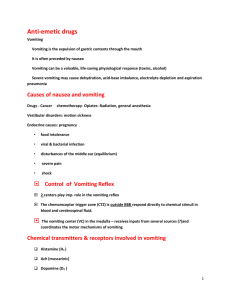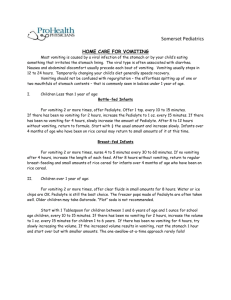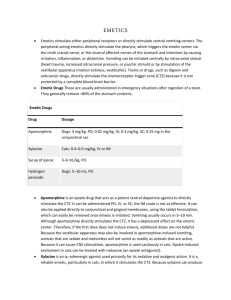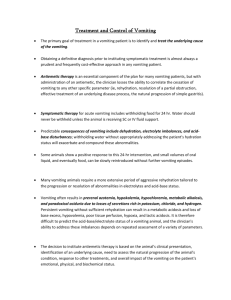Yak research paper
advertisement
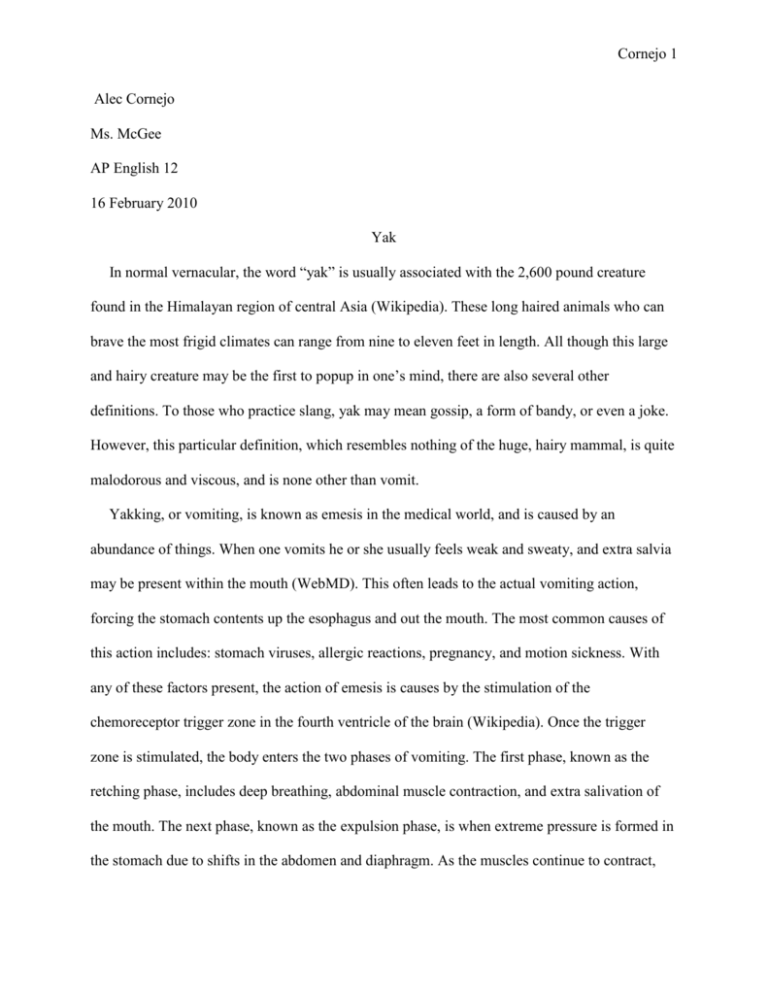
Cornejo 1 Alec Cornejo Ms. McGee AP English 12 16 February 2010 Yak In normal vernacular, the word “yak” is usually associated with the 2,600 pound creature found in the Himalayan region of central Asia (Wikipedia). These long haired animals who can brave the most frigid climates can range from nine to eleven feet in length. All though this large and hairy creature may be the first to popup in one’s mind, there are also several other definitions. To those who practice slang, yak may mean gossip, a form of bandy, or even a joke. However, this particular definition, which resembles nothing of the huge, hairy mammal, is quite malodorous and viscous, and is none other than vomit. Yakking, or vomiting, is known as emesis in the medical world, and is caused by an abundance of things. When one vomits he or she usually feels weak and sweaty, and extra salvia may be present within the mouth (WebMD). This often leads to the actual vomiting action, forcing the stomach contents up the esophagus and out the mouth. The most common causes of this action includes: stomach viruses, allergic reactions, pregnancy, and motion sickness. With any of these factors present, the action of emesis is causes by the stimulation of the chemoreceptor trigger zone in the fourth ventricle of the brain (Wikipedia). Once the trigger zone is stimulated, the body enters the two phases of vomiting. The first phase, known as the retching phase, includes deep breathing, abdominal muscle contraction, and extra salivation of the mouth. The next phase, known as the expulsion phase, is when extreme pressure is formed in the stomach due to shifts in the abdomen and diaphragm. As the muscles continue to contract, Cornejo 2 the pressure is suddenly released and the vomiting occurs. “The relief of pressure and the release of endorphins into the bloodstream after the expulsion causes the vomiter to feel better,” (Wikipedia.) Due to the large role of the brain in vomiting, and the intense muscle usage, vomiting, or yakking, is regarded as a very complex process. The color and consistency of yak, greatly depends on the recent food and drinks one has consumed prior to vomiting. Low viscosity vomiting generally means a previous diet of liquids or watery foods. However, if the vomit is chunky and/or thick, a recent intake of solid foods can be deduced. This type of vomiting is known as coffee ground vomiting. Coffee ground vomiting also means that there is less bleeding in the stomach because the gastric acid has had time to change the composition of the blood (Wikipedia). Furthermore, the color of vomit is closely related to the liquid intake. For example, purple or red fluids tend to compose red vomit, which is commonly mistaken with blood in the vomit. However, if there is actual blood in the vomit, the color would be of a darkened red, and suggests profuse bleeding in the stomach (Wikipedia). Another common color of vomit is green or yellow; either of these colors suggests that bile is being released in to the stomach. As vomit may be chromatic in looks, the treatments for its symptoms are just as numerous. During the early stages of yakking, there are many ways to help prevent or lessen the symptoms of vomiting. First off, one should never prolong vomiting, as it often causes more discomfort; staying home and not forcing back the vomit will often lead to less incidents of getting sick. Furthermore, drinking clear liquids and avoiding food will also help lessen the intensity of vomiting. Vomiting tends to drain liquids from the body, leading to dehydration, so replenishing these fluids is crucial. Also, one should avoid eating food for six hours, and return to the regular diet within 24 hours (Mothernature). This will allow the stomach to rest and heal. Cornejo 3 A non-conventional method is chewing gum. Chewing gum reduces air sickness, thereby preventing vomiting (Mothernature). Lastly, medicine is never a wrong path to take. Pink medicines, like Pepto-Bismol, will help settle the stomach and prevent future vomiting. Even though many methods may reduce the symptoms of vomiting, or cure it completely, a doctor should always be consulted if vomiting does not cease within 24 hours (Mothernature). Yak. Yakked. Yakking. It may be a glass of brandy. A group of people gossiping idly about the new kid. Or even a joke. However, when the chemoreceptor trigger zone is stimulated, and pushes the stomach content up through the esophagus, projecting a chunky substance everywhere, Pepto-Bismol will have to do; that is, if the yak isn’t a huge, hairy mammal in the mountains of the Himalayans. Cornejo 4 Works Cited MotherNature. Rodale. Web. 14 Feb. 2010. <http://www.mothernature.com/Library/Bookshelf/Books/16/259.cfm>. WebMD. Healthwise. Web. 14 Feb. 2010. <http://children.webmd.com/tc/nausea-and-vomitingage-4-and-older-topic-overview>. Wikipedia contributors. "Vomiting.” Wikipedia, The Free Encyclopedia. Wikipedia, The Free Encyclopedia, 6 Feb. 2010. Web. 14 Feb. 2010. Wikipedia contributors. "Yak.” Wikipedia, The Free Encyclopedia. Wikipedia, The Free Encyclopedia, 9 Feb. 2010. Web. 14 Feb. 2010.
![Questionnaire used in the study Demographics GENDER: M [ ] F](http://s3.studylib.net/store/data/006712173_1-21c851410b04058d524e1b79e54e32b0-300x300.png)

